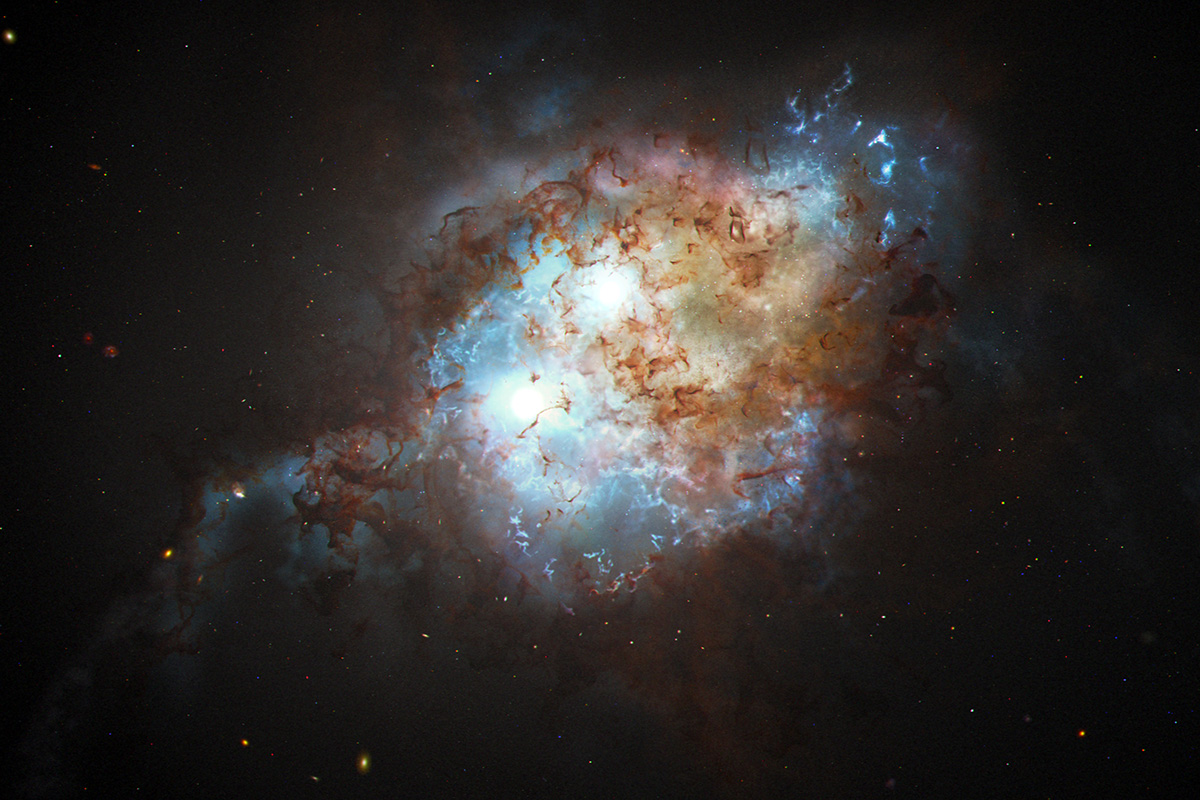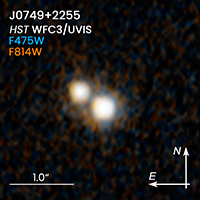
This artist's concept shows the brilliant glare of two quasars residing in the cores of two galaxies that are in the chaotic process of merging. The gravitational tug-of-war between the two galaxies ignites a firestorm of star birth.
Graphic courtesy NASA, ESA and Joseph Olmsted of STScI
The early universe was a rambunctious place where galaxies often bumped into each other and even merged. Using NASA's Hubble Space Telescope and other space and ground-based observatories, astronomers made an unexpected and rare discovery: a pair of gravitationally bound quasars, both blazing away inside two merging galaxies. They existed when the universe was just 3 billion years old.
The results of a new study led by researchers at the University of Illinois Urbana-Champaign and Johns Hopkins University are published in the journal Nature.
Quasars are bright objects powered by voracious, supermassive black holes blasting out ferocious fountains of energy as they engorge themselves on gas, dust and anything else within their gravitational grasp, the researchers said.
"We don't see a lot of double quasars at this early time in the universe, and that's why this discovery is so exciting," said graduate student Yu-Ching Chen of U. of I., who is the lead author of the study.

This compass image shows a Hubble Space Telescope photograph of a pair of quasars that existed when the universe was just 3 billion years old.
Image courtesy NASA, ESA, Yu-Ching Chen, Hsiang-Chih Hwang, Nadia Zakamska and Yue Shen
There is increasing evidence that large galaxies are built up through mergers. Smaller systems come together to form bigger systems and ever-larger structures. During that process, pairs of supermassive black holes formed within the merging galaxies. "Knowing about the progenitor population of black holes will eventually tell us about the emergence of supermassive black holes in the early universe, and how frequent those mergers could be," said Chen.
"We're starting to unveil this tip of the iceberg of the early binary quasar population," said Illinois astronomy professor and study co-author Xin Liu. "This is the uniqueness of this study. It is actually telling us that this population exists, and now we have a method to identify double quasars that are separated by less than the size of a single galaxy."
This was a needle-in-a-haystack search that required the combined power of NASA's Hubble Space Telescope and the W.M. Keck Observatories in Hawaii. The European Space Agency's Gaia space observatory helped in the original discovery of the double quasar.
"Hubble's sensitivity and resolution provided pictures that allow us to rule out other possibilities for what we are seeing," said Chen. Hubble shows unequivocally that this is indeed a genuine pair of supermassive black holes rather than two images of the same quasar created by the optical effects of a foreground gravitational lens. And Hubble shows a tidal feature from the merging of two galaxies, where gravity distorts the shape of the galaxies, forming two tails of stars.
However, Hubble's sharp resolution alone isn't good enough to go looking for these dual-light beacons, the researchers said. The team enlisted Gaia, a satellite and research mission launched in 2013, to pinpoint potential double-quasar candidates. Gaia measures the positions, distances and motions of nearby celestial objects very precisely. The quasars appear as single objects in the Gaia's data because they are so close together. However, its instruments can pick up a subtle, unexpected jiggle that mimics an apparent change in position of some of the quasars it observes.
In reality, the quasars aren't moving through space in any measurable way, the team said. Instead, their jiggle could be evidence of random fluctuations of light as each member of the quasar pair varies in brightness on timescales of days to months, depending on their black hole's feeding schedule. This alternating brightness between the quasar pair is similar to seeing a railroad crossing signal from a distance. As the lights on both sides of the stationary signal alternately flash, the sign gives the illusion of jiggling.
Another challenge is that because gravity warps space like a funhouse mirror, a foreground galaxy could split the image of a distant quasar in two, creating the illusion that it is really a binary pair. The Keck telescope was used to make sure there was no lensing galaxy between Earth and the suspected double quasar.
Because Hubble peers into the distant past, this double quasar no longer exists. Over the intervening 10 billion years, their host galaxies have likely settled into a giant elliptical galaxy, like the ones seen in the local universe today. And, the quasars have merged to form a gargantuan, supermassive black hole at its center. The nearby giant elliptical galaxy, M87, has a monstrous black hole weighing 6.5 billion times the mass of our Sun. Perhaps this black hole was grown from one or more galaxy mergers over the past billions of years, the researchers said.
The upcoming NASA Nancy Grace Roman Space Telescope, having the same visual acuity as Hubble, is ideal for binary quasar hunting. Hubble has been used to painstakingly record data from individual targets. But Roman's very wide-angle infrared view of the universe is 200 times larger than Hubble's. "A lot of quasars out there could be binary systems. The Roman telescope can do huge improvements in this research area," Liu said.
The Hubble Space Telescope is an international collaboration between NASA and ESA. NASA's Goddard Space Flight Center in Greenbelt, Maryland, manages the telescope. The Space Telescope Science Institute in Baltimore, Maryland, conducts Hubble and Webb science operations. STScI is operated for NASA by the Association of Universities for Research in Astronomy in Washington, D.C.






